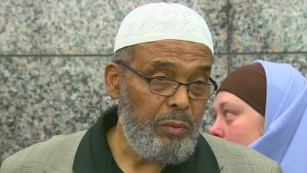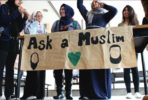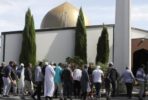(CNN) Soon after Usaamah Rahim was killed by officers earlier this week, questions arose about his shooting death and his alleged terror plot.
Was the 26-year-old security guard simply the latest man to be shot dead by police? Authorities quickly showed a video to community leaders to counter the social media claim.
Was Rahim a radicalized religious extremist? The FBI said his social media posts point in that direction.
Rahim initially wanted to behead Islam critic Pamela Geller, who had organized a Prophet Mohammed cartoon drawing contest, law enforcement officials told CNN. But then he switched targets to police officers, because he found them easier to access.
Rahim was fatally shot Tuesday after waving a military knife at law enforcement officers in Boston.
As the investigation continues, questions remain open. From a possible ISIS connection to additional suspects in his case, here’s what we know and don’t know about the case.
THE ASSOCIATES
What we know:
Authorities say an FBI anti-terror task force had been watching not only Rahim but two associates as well. The pair may have helped Rahim or at least known what he was up to, which could lead to terror- and conspiracy-related charges for them.
They have named one of them, David Wright, 25, who already faced federal obstruction charges this week. Wright is accused of destroying Rahim’s smartphone to conceal evidence of their plan. He could spend up to five years in jail if convicted.
The two appeared to use coded language and names in their exchanges, the FBI said. Wright’s lawyer, Jessica Hedges, cast doubt on the investigation connecting her client with the case.
What we don’t know:
Were more people involved in the alleged plot? Police on Tuesday conducted a raid on a property in Rhode Island in connection with the investigation and took a third person in for questioning. The FBI is investigating whether there are overseas connections to the case, but law enforcement officials believe they have tracked down everyone involved in the Boston terror plot and are not looking for other suspects within the U.S.
THE TERROR CONNECTION
What we know:
The FBI said Rahim’s behavior changed over time, as they observed him, and that he made social media threats against police. Investigators said ISIS and other extremists radicalized him.
On his Facebook page, Rahim “liked” a page about ISIS in 2012. He has also “liked” extremist preachers.
“There’s a certain tone to it, and it points to a certain direction,” said radicalization researcher Nick Kaderbhai from King’s College in London. “We can look back and say the warning signs were there.”
The case has highlighted fears about the deepening reach of the terror group in the United States. U.S. officials say it only takes online communication for ISIS to inspire and train operatives to plot attacks in the country.
Rahim graduated in 2007 from Brookline High School in the Boston suburb. He enrolled in Brookline in 2004 for 10th grade after spending his ninth-grade year at the Academic International School in Saudi Arabia. Two years before his schooling in Saudi Arabia, he attended the Baker School in Chestnut Hill, Massachusetts.
Rahim had “no major disciplinary infractions” at Brookline High and after graduation he went to college in Florida. He emailed his former dean and guidance counselor at Brookline “thanking them for the help that they provided in getting him through high school,” said William H. Lupini, the superintendent of Brookline schools.
The dean and counselor remember Rahim as being bright and thriving from the attention of his teachers and tutors, said Lupini.
What we don’t know:
Despite suspicions Rahim’s social media activity has generated, any interpretation that these were warning signs is a product of hindsight, Kaderbhai said.
Had he seen the Facebook feed before the police confrontation with Rahim, Kaderbhai said, he would not have thought much of it. “It’s fairly banal; it’s fairly benign,” Kaderbhai said. It didn’t look like a feed typical of someone determined to commit jihad.
There were no images of Muslims under threat. “There was very little talk of politics,” Kaderbhai said. Rahim’s social media posts could have easily belonged to someone who believes Islam and Sharia should determine how a society works, but who is unwilling to become violent to achieve that end, he said.
The public may have to wait for the investigation to reveal more about Rahim’s possible radicalization, as those who knew Rahim casually said the suspicions against him caught them by surprise.
How deep does Rahim’s network run?
THE SHOOTING
What we know:
An FBI anti-terror task force believed Rahim posed an imminent threat and confronted him with it in public, authorities said. Their guns were not drawn at the time; surveillance video shows this, Boston police said.
Then, Rahim pulled a knife and went after them. The officers fired to protect themselves.
Afterward, social media lit up with the claim that Rahim had become the latest young man to be gunned down by police. Rahim’s brother, Ibrahim Rahim, may have triggered it, when he posted on social media that Usaamah Rahim was shot three times in the back while on the phone with their father.

To dispel the claim, police invited religious and civil rights leaders from the community to watch surveillance video of the shooting.
Darren Williams from the Urban League summed up what they saw — and didn’t see.
“What the video does reveal to us very clearly is that the individual was not on the cell phone, the individual was not shot in the back and that the information reported by others that that was the case was inaccurate,” he said.
What we don’t know:
The viewers said the video doesn’t reveal everything, including a clear view of the knife Rahim allegedly wielded.
“We do see a very vague video that is not clear as to what transpired. It wasn’t at a bus stop. He wasn’t shot in the back, and there is not detail enough on the video to tell us exactly what happened,” said Imam Abdullah Faaruuq, a Muslim community leader invited to watch the footage.
Authorities want to wait until Rahim’s family has seen the footage before releasing it to the public.
THE EVIDENCE
What we know:
Officers say Rahim wielded a knife at them before they shot him.
Rahim purchased three military fighting knives with blades longer than 8 inches on Amazon, court documents said.
He told his associate David Wright about them. “I just got myself a nice little tool. … You know it’s good for carving wood and … carving sculptures,” Rahim said in a conversation that was recorded, according to court documents.
He told Wright that he was going after “boys in blue,” a reference to police, because he had grown impatient and wanted a quick target. “I can’t wait that long,” he said.
The two used coded language, authorities said. Killing police was termed “vacation.” The FBI thought Rahim would act on his plans on Tuesday or Wednesday, so they sent officers to confront him.
What we don’t know:
Police have conducted raids in Massachusetts and Rhode Island and questioned people in the case. They have not released all of their findings yet.
Source: http://edition.cnn.com







